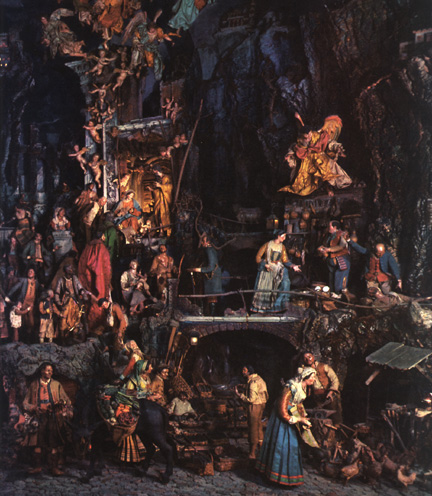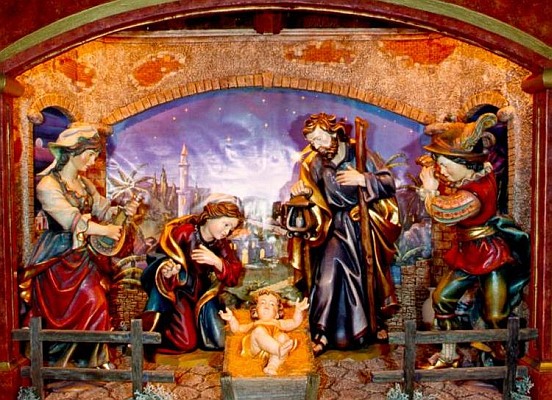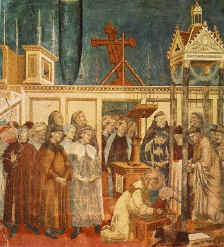
Nicholas was born at Patara in Lycia in the third century. His parents, who had been growing old without having a child, are said to have obtained him by force of prayer. Nicholas, losing his father and mother at an early age, devoted his life to the poor and afflicted of every kind. Late in his life, after he had been made Bishop of Myra in Asia Minor (present-day Turkey) Nicholas suffered imprisonment for his faith. He died tranquilly in his episcopal city pronouncing the words, "Into Thy hands, O Lord, I commend my spirit"-. Since 1087 his relics have been preserved at Bari in Italy.
Devotion to St. Nicholas (Santa Claus) began in his native Asia Minor, and was brought to Russia by an emperor who was witness to his miraculous works. The devotion spread through Lapland and into Scandinavia, thence to all Europe and across to the New World. In early times, Nicholas was pictured as a kind, lean, ascetic bishop, but in America he became fat and jolly. His miter turned into a winter bonnet, his vestments became a snow suit. He retained his reindeer from Lapland, his love for chimneys from his own Asia Minor, and his love of children from all time.
Of all the feasts throughout the year the celebration of Christmas Day and Christmas Eve are the most popular of all, both for children and for adults. There are more traditions and customs associated with Christmas in all Christian countries than with any other feast. The Epiphany, on January 6, is another important feast. . The celebration of these two feasts may be explained only upon an historical basis. Christmas is the Western celebration of the Nativity of the Lord, and the Epiphany is the Christmas of the Eastern.. There is a very important difference to be noted between the two great Christmas feasts. The East adopted Christmas from the West; the West received the feast of the Epiphany from the East.
On the feast of Christmas, Christ is born to us in the intimacy of the family represented by Mary, Joseph and the shepherds; at the Epiphany, He manifests to the entire world His glory and His kingship, which are represented by the adoration of the Magi. The date of December 25 was established about the year 320, and the Popes seem to have chosen the twenty-fifth day of December principally to divert the attention of the people from the celebration of a pagan feast of the Mithras cult which was called the "Birthday of the Unconquered Sun" (Natalis Solis Invicti).
The ancient Roman Church followed, in this matter, the example of the venerable Church of Jerusalem. The faithful there assembled during the night at the grotto of the Nativity in order to sanctify the hour of the birth of the Lord by the celebration of Holy Mass. At the end of this Mass they returned to Jerusalem. In the Church of the Resurrection in that city, what better means could they take than to celebrate Christmas with the shepherds? This was the second Mass. During the day they again assembled in church for the solemn Office of the feast. In this manner it became customary to celebrate three Masses on Christmas Day. This custom was initiated at Rome. The first Mass was celebrated during the night in the church of the crib at St. Mary Major (the church of St. Mary Major was considered to be the Bethlehem of the Roman people). The second Mass was celebrated in the Roman church of the Resurrection. The third Mass was celebrated at the basilica of St. Peter. This custom spread from Rome to the entire Occidental church. Since the time when priests of the Roman rite were permitted to celebrate Mass each day the custom became established that every priest might celebrate three Masses on Christmas Day.
Throughout the Middle Ages, Christmas came to be celebrated more and more. Especially during the period from the twelfth to the sixteenth centuries all the arts and crafts of the Christian nations were made serviceable to the festivities associated with the Nativity of the Saviour. Plays and songs, carols and dances, spices and flowers, images and statues--all creation was made to serve the celebration of the feast. The foundation of all these customs and traditions was always Holy Mass--the Christ-Mass.

In many countries of Europe a sharp change in the Christmas solemnities came with the Protestant Reformation during the sixteenth century. The spiritual and scriptural foundation of the liturgy, including the Mass itself, was ridiculed and forbidden. The Calvinists and Puritans in particular condemned all religious celebration of the feast, and when the "new" method of celebrating Christmas was revived it tended to become only a more or less pagan feast of good-natured and humanitarian reveling. The attempt was particularly successful in England, and post-Reformation English attitudes concerning Christmas have affected most of modern notions concerning the celebration of the holidays.
When the Puritans came to political power in England, they immediately proceeded to outlaw Christmas. It was their contention that no feast of human institution should ever outrank the Sabbath (Sunday). Since Christmas was the most important of the non-Sunday festivals, it was abolished altogether. The first ordinances issued forbidding church services and civic festivities on Christmas came in 1642, finally, on June 3, 1647, Parliament enacted a ruling that the feast should no longer be observed under pain of punishment.
Riots and strife broke out among the people, but the government stood firm and even broke up celebrations by force of arms, though the punishments were not too severely inflicted. With the restoration of the monarchy in 1660, the observance of the "old" Christmas returned with a "new" attitude. The religious observance of Christmas was almost entirely replaced by amusement and reveling over plum pudding, goose, capon, minced pie and roast beef, with decorations of mistletoe, holly and ivy, and the yule log.
Two of the best exemplifications of this "new Christmas without Christ" are to be found in the "Christmas Stories" of Charles Dickens, and the "Sketch Book" of Washington Irving. We must admit that present-day celebration of Christmas is greatly affected by these works. The only thing that may be said in favor of these well- written books is that they do contain interesting stories upholding a spirit of good will to men and of generosity to the poor.
The unfortunate zeal of the Puritans has certainly influenced the celebration of Christmas. It is very difficult to realize that Christmas was outlawed in New England until the second half of the last century. As late as 1870, classes were held in the public schools of Boston on Christmas day, and any truant pupil was gravely punished or even publicly dismissed from school.
Through the influx into the United States of America of German, Irish and French immigrants, together with the multiple immigrations from all the European nations, Christmas has been more fully restored within the last seventy years in this country. Two currents are now manifest: the pagan, good-natured humanitarian sort of celebration represented upon Christmas cards by sleigh bells, Santa Claus, peppermint sticks and the like, but bereft of the central figure: Christ and the Christian spiritual and traditional customs originating from medieval Christian Europe gradually finding their way back with the added impetus of recent tragedies and disasters.
Culinary art has exceeded itself at this season. Greater portion of the cooking had to be done in advance. Swiss "krabeli," Greek "malachrino" (spice cake), and German "lebkuchen" and "stollen" would delight the hearts of all. The very shape of "stollen" is supposed to represent the Christ Child, and the folds on top of the loaf swaddling clothes. "Lebkuchen" or life cake is an excellent reminder of the Bread of Life.
Among English recipes are to be found everything from boar's head to plum pudding, with accent upon hot buttered rum and eggnog. Sponge cake or an Italian cream tart would make an excellent dessert, quickly prepared by the older girls. The Polish Christmas Eve supper, called the "wigilia," is perhaps the most complicated culinary celebration of the vigil. "In the homes of that country," the "Feast Day Cook Book" tells us, "stalks of grain are placed in the four corners of the dining room with a prayer for plenty in the years to come. Then bits of hay, symbolic of the manger in Bethlehem, are strewn beneath the tablecloth, which must be hand woven. The youngest child is set to watch for the first star of the evening, and when it appears he runs to tell the rest of the family. Then supper begins, as tradition has ordered it, with the breaking of the "oplatek," a semi-transparent unleavened wafer made in an iron mold and stamped with scenes of the Nativity. Each one at the table breaks off a piece and eats it as a symbol of their unity in Christ...."
The soups are three in number, followed by three fish dishes accompanied by noodles, cabbage and dumplings. The desserts are also three, one of which is always a fruit compote with twelve dried fruits symbolic of the Twelve Apostles. At the end of the supper, carols are sung and presents are exchanged. The remainder of the food is often given to the animals in the hope that all living things may prosper by the food served in memory of Our Lord's first night on earth.
In Austria on Christmas Eve, every house is filled with the aroma of "fruchtbrot" as it receives the visit of the "anglockler" or bell-ringers, who go from place to place singing carols, sometimes two of their number impersonating Mary and Joseph seeking shelter at the inn.
In Germany the Christmas observances go back to the start of Advent, when a wreath is hung, usually from the ceiling of the dining room, and to it a silver star is added each day, and each week a red candle. Also in advance is prepared the "Christstollen" (a long loaf of bread made with dried fruits and citron) as well as the "lebkuchen" and the marzipan, regarded as important holiday foods. On Christmas Eve the family gathers beneath the Advent wreath and sings carols. Then the Christmas tree is lighted and the gifts are distributed.
The Christmas candle was sometimes placed upon the "lichtstock," a wooden pole decorated with evergreens. On Christmas Eve, it was set up in the home and It was often the custom to surround this candle with a laurel wreath, symbolic of victory over Satan, and then to keep the light burning throughout the holy night and every night during the festival season. Nearly every nation has adopted the Christmas candle. The opening of the eternal gates through which the King of Glory may enter is indicated by the wreath on the door of homes at Christmastide. The Advent wreath, which accompanied the family throughout the season of preparation may be taken down. The violet ribbons are removed, and it is gloriously re-decorated with white and gold. It is then placed upon the door as a symbol of the welcome of Christ into the home and hearts of its occupants. On Christmas Eve the whole house should be strewn with garlands and made ready for the Light of the World. The crib is set in a special place of honor, for tonight the central figure of the Nativity scene is to arrive.
The pyramid of candles which later became customary was replaced by the Christmas tree during the seventeenth and eighteenth centuries.
In Ireland the family lights a holly-bedecked candle and prays for the living and the dead. They are particularly fond of placing a candle in the window. During the English persecutions priests were obliged to go into hiding, and it was the hope of every Irish family to have the refugee come into their home for the celebration of Mass on Christmas Eve. The candle in the window indicated his welcome into their home. When the English authorities requested an explanation of this custom the Irish simply explained that they lit the candles and kept the doors unlocked so that if Mary and Joseph were looking for a place to stay they knew that they would be welcome. This "superstition" was considered harmless by the English, and the Irish were often rewarded by the Real Presence of Christ at Holy Mass.
The Christmas fires burning on the peaks of the Alps in central Europe were a colorful sight. Like flaming stars they hung in the dark heavens during Holy Night, burning brightly and silently as the farmers from around the mountainsides walk through the winter night down into the valley for midnight Mass. Each person carried a lantern, swinging it to and fro; the night seems alive with hundreds of glow worms converging towards the great light at the foot of the mountains-- the parish church--shining and sparkling, a 'Feast of Lights' indeed. No one who had witnessed this scene on Christmas Eve in Austria, Bavaria or Switzerland will ever forget it.
The singing of hymns and carols is the natural adornment of Christmas customs and stories at home. There is a great wealth of Christmas carols from many times and many lands. Most of these carols have a popular appeal and nearly all of the important ones have been translated into singable English. Many indeed are available in recordings, both in the original tongue and in English. Hymns and carols as "Silent Night" and "Adeste Fideles"; are all well known Ancient Latin and foreign carols broaden our understanding of Christmas. They are easily understood and belong to the international treasury of folklore.
"Oh, Publish the Glad Story." is often executed in Austria, France and the Spanish countries. It is a dramatic rendition of the Holy Family's fruitless efforts to find a shelter in Bethlehem. Joseph and Mary, tired and weary, knock at door after door, humbly asking for a place to stay. Realizing that they are poor, the owners refuse their request with harsh words, until the Holy Family finally decide to seek shelter in a stable. Usually the whole performance is sung and often it is followed by a happy ending showing a tableau of the cave with the Nativity scene....
In South America the candle is sometimes placed in a paper lantern decorated with Nativity scenes. The custom of the Spanish "Posada" (the Inn), is traditional in South-American countries, especially Mexico. On an evening between December 16 and 24, several neighboring families gather in one house, where they prepare a shrine, handsomely decorated, and beside it a crib with all its traditional figures, but the manger is empty. At night a priest comes to the house, reads prayers and burns incense before the pictures of Mary and Joseph. Then a procession is formed, the two images carried at the head. The group moves through the house, reciting a litany and chanting hymns until it reaches a room on the top floor where a carol is sung in which St. Joseph begs for a shelter. The people stationed within the room respond, refusing St. Joseph's request as part of the carol. The procession then proceeds to the place where the altar has been prepared. Pictures of Joseph and Mary are put in the shrine, venerated with prayer and incense, and all those present are blessed by the priest. Thus the religious part of the "Posada" ends. Then comes a party for the adults consisting of games and refreshments, while the children are entertained with the "pinata." This is a fragile clay jar suspended from the ceiling and filled with candy and other goodies. The object is to break the jar with a stick so the contents spill and everybody rushes pell-mell for some of its treasures.
The Ukrainians place their candle in a loaf of bread, reminiscent of the Bread of Life and the Light of the Nations.
In France the Christmas light often consisted in the molding of three individual candles into one at the base in order to give honor to the Most Holy Trinity.
St. Paul: says "Let us be as Christ, for Christ is also as we. Let us become holy for His sake, for He also was made man for us. He took upon Himself what was poorer that He might give what was more glorious; He was made poor that we might be enriched by that poverty; He took the form of a servant that we might be set at liberty. He descended that we might be elevated.... Let everyone give all things; let him offer all things to Him who gave Himself as the price of redemption for us and as a recompense for our fault. But he can give nothing as great as when, rightly understanding this mystery he offers himself and becomes for the sake of Him everything which He has become for our sake."
The Crib

Fresco of the
first crib by Giotto and assistants
in Basilica of Saint Francis in Assisi
St.Francis
| < Prev | Next > |
|---|
















